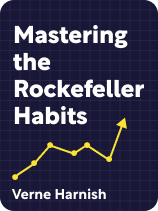

This article is an excerpt from the Shortform book guide to "Mastering the Rockefeller Habits" by Verne Harnish. Shortform has the world's best summaries and analyses of books you should be reading.
Like this article? Sign up for a free trial here.
What makes weekly team meetings truly effective? How can you structure these gatherings to maximize productivity and team engagement?
In Mastering the Rockefeller Habits, Verne Harnish contends that weekly meetings serve as a crucial touchpoint for teams to celebrate wins, address challenges, and align on strategic goals. Following a specific format can transform these gatherings from mundane check-ins to powerful drivers of growth.
Keep reading to explore how to make your weekly meetings more purposeful and productive.
Weekly Meetings
Harnish argues that everyone in the company should meet with relevant coworkers every week for 30 to 60 minutes. These weekly meetings should follow a specific agenda.
(Shortform note: In The Advantage, Patrick Lencioni recommends taking time at the beginning of every weekly meeting to collaboratively create an agenda rather than strictly following the same one every week. Every participant shares how much progress they’ve made on specific to-do items, and they create an agenda that dedicates more time to discuss areas where progress is slowest. He also recommends that these meetings last 45 to 60 minutes—perhaps because it takes extra time to assemble an agenda.)
Item #1: Celebrate
First, team members share any good news that’s happened to them recently, whether at work or in their personal lives. According to Harnish, this will boost everyone’s mood, setting the stage for a productive meeting.
(Shortform note: Positive emotions help facilitate product meetings by counteracting the effects of stress. In Leaders Eat Last, Simon Sinek contends that when workers feel stress, the neurochemical cortisol sends their body into “survival mode,” focusing their attention on potential threats and distracting them from the exploratory thinking necessary for problem-solving.)
Item #2: Review Suggestions for Improvement
Second, the team reviews suggestions from employees or customers regarding how the business could improve. Harnish suggests picking a recurring problem and assigning someone to investigate and try to solve it in the upcoming week. Even if you’re only able to solve a tiny problem each week, if your solution lasts, those improvements are cumulative. For instance, if a coding team complains that an automated email list bombards them with messages that aren’t relevant to them, you could assign someone to take their team off the company-wide email list. Fix enough little problems like this, and you’ll have radically transformed your company.
(Shortform note: In The Slight Edge, Jeff Olson contends that the main reason people fail to take the small, cumulative actions that lead to success is that they don’t seem exciting. For instance, executives get more instant gratification by announcing the grand launch of a new product line than by switching to a faster internet service provider or automating a repetitive data entry task. However, avoiding these tasks for long enough can cause significant damage to your business, and by that time, it may be too late to salvage it.)
To learn what recurring problems are hurting your business, Harnish recommends sending out surveys to every employee asking what the company could be doing better for them—and for customers. Then, set up a system that allows employees to submit feedback at any time, and encourage them to do so for every issue they encounter, no matter how small. Do the same for your customers. This way, you’ll always have feedback to review and act upon in every weekly meeting.
(Shortform note: In Raving Fans, Ken Blanchard and Sheldon Bowles concur that asking employees what the company can do better for them is vital to a business’s success. When employees are happy with their jobs, they do better work and ultimately deliver better service to your customers. To this end, Blanchard and Bowles recommend viewing employees as your internal customers: People whom you’re obligated to serve just as much as “external” customers. Additionally, the authors assert that building systems to consistently collect and respond to feedback is important because they help you build credibility. Credibility can only be built over time, so your efforts need to be based on systems, not just one-time plans.)
Item #3: Review Profitability Indicators
Next, Harnish explains that the team reviews more detailed Profitability Indicators than those you review in daily meetings. In particular, gauge how much progress you’ve made toward the company’s quarterly goals. As in daily meetings, this big-picture awareness of the company will help people set smarter strategies as they work.
(Shortform note: In Traction, Gino Wickman also recommends reviewing metrics in weekly meetings that track your progress toward quarterly goals. Wickman recommends that rather than simply allowing these numbers to add context to the team’s strategies, you should respond to them more actively. If any metrics reveal that the team isn’t on track to hit their goals, devote part of the meeting to fixing this problem using the “Issues Solving Track.” This is a three-step mini-agenda you can use to quickly resolve issues: Identify the problem, discuss potential solutions, and assign someone to solve the problem during the upcoming week.)
Item #4: Strategize About Weekly Goals
Last, Harnish advises the team to use the bulk of the meeting to discuss strategy. Specifically, identify a narrow subgoal that will help you achieve your themed quarterly target, and open the floor for suggestions on how to accomplish it. For example, if your quarterly goal is to lower your manufacturing costs by 30%, at one weekly meeting you could brainstorm ways to reduce your transportation expenses. Limit yourself to discussing a narrow subtopic like this each week to give yourself the dedicated time needed to dive deeply into the topic at hand.
(Shortform note: In Working Backwards, Colin Bryar and Bill Carr argue that strategy meetings are most effective when participants have time to think deeply before presenting their ideas and thoroughly digest the ideas of others before responding. The authors recommend that rather than asking people to generate strategies in open discussion, you should require one presenter to research the topic at hand (for instance, a chosen subgoal) before the meeting and write a comprehensive document in which they argue in favor of a strategy. Then, for several minutes at the beginning of the meeting, all participants read copies of this document and think it over. This ensures that everyone has thought deeply about the topic before an open discussion.)

———End of Preview———
Like what you just read? Read the rest of the world's best book summary and analysis of Verne Harnish's "Mastering the Rockefeller Habits" at Shortform.
Here's what you'll find in our full Mastering the Rockefeller Habits summary:
- What an oil tycoon can teach you about business
- How knowing your business’s unique value is key to beating the competition
- Why you should create fun themes for your quarterly goals






